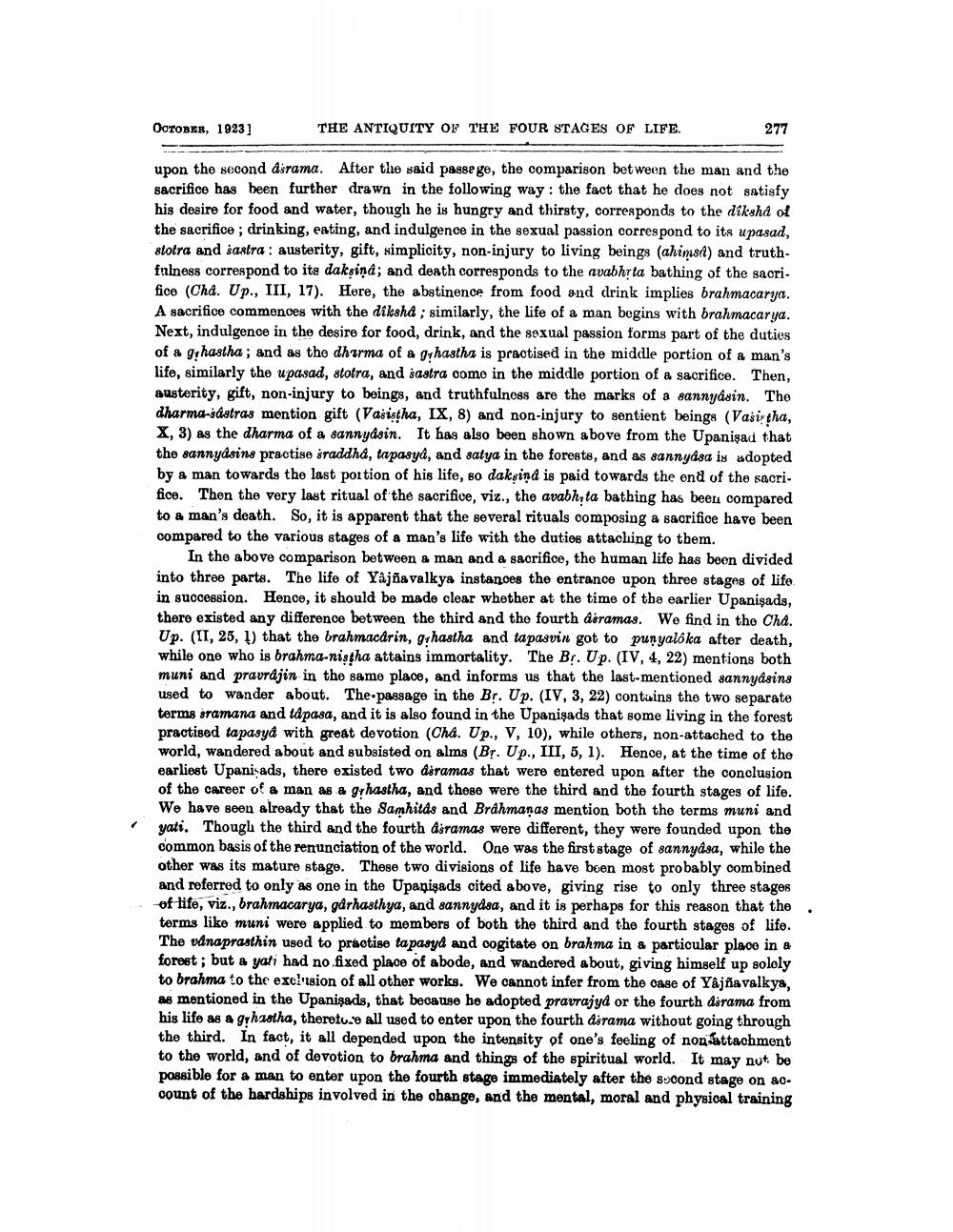________________
OCTOBER, 1923]
THE ANTIQUITY OF THE FOUR STAGES OF LIFE.
277
upon the second asrama. After the said passe ge, the comparison between the man and the sacrifice has been further drawn in the following way: the fact that he does not satisfy his desire for food and water, though he is hungry and thirsty, corresponds to the diksha of the sacrifice ; drinking, eating, and indulgence in the sexual passion correspond to its upasad, stotra and sastra : austerity, gift, simplicity, non-injury to living beings (ahimsi) and truthfulness correspond to its daksind; and death corresponds to the avabhrta bathing of the sacrifice (Cha. Up., III, 17). Here, the abstinence from food and drink implies brahmacarya. A sacrifice commences with the diksha , similarly, the life of a man begins with brahmacarya. Next, indulgence in the desire for food, drink, and the sexual passion forms part of the duties of a grhastha; and as the dharma of a grhastha is practised in the middle portion of a man's life, similarly the upasad, stotra, and sastra come in the middle portion of a sacrifice. Then, austerity, gift, non-injury to beings, and truthfulness are the marks of a sannyásin. The dharma-sástras mention gift (Vasistha, IX, 8) and non-injury to sentient beings (Vašistha, X, 3) as the dharma of a sannyasin. It has also been shown above from the Upanişad that the sannydsins practise sraddha, tapasyd, and satya in the forests, and as sannyasa is adopted by & man towards the last portion of his life, so dakvind is paid towards the end of the sacrifice. Then the very last ritual of the sacrifice, viz., the avabhıta bathing has been compared to a man's death. So, it is apparent that the several rituals composing a sacrifice have been compared to the various stages of a man's life with the duties attaching to them.
In the above comparison between a man and a sacrifice, the human life has been divided into three parts. The life of Yâjña valkya instances the entrance upon three stages of life in succession. Hence, it should be made clear whether at the time of the earlier Upanisads, there existed any difference between the third and the fourth asramas. We find in the Cha. Up. (II, 25, 1) that the brahmacarin, grhastha and tapasvin got to punyalóka after death, while one who is brahma-nistha attains immortality. The Br. Up. (IV, 4, 22) mentions both muni and pravrdjin in the same place, and informs us that the last-mentioned sannyasins used to wander about. The passage in the Br. Up. (IV, 3, 22) contains the two separate terms sramana and tapasa, and it is also found in the Upanişads that some living in the forest practised tapasyd with great devotion (Cha. Up., V, 10), while others, non-attached to the world, wandered about and subsisted on alms (Br. Up., III, 5, 1). Hence, at the time of the earliest Upani ads, there existed two diramas that were entered upon after the conclusion of the career of a man as a grhastha, and these were the third and the fourth stages of life. We have seen already that the Samhitds and Brahmanas mention both the terms muni and yati. Though the third and the fourth asramas were different, they were founded upon the common basis of the renunciation of the world. One was the first stage of sannyása, while the other was its mature stage. These two divisions of life have been most probably combined and referred to only as one in the Upanişads cited above, giving rise to only three stages of life, viz., brahmacarya, gårhasthya, and sannydsa, and it is perhaps for this reason that the terms like muni were applied to members of both the third and the fourth stages of life. The vanaprasthin used to practise tapasyd and cogitate on brahma in a particular place in a forest; but a yati had no fixed place of abode, and wandered about, giving himself up sololy to brahma to the exclusion of all other works. We cannot infer from the case of Yâjñavalkys, as mentioned in the Upanişads, that because he adopted pravrajya or the fourth dsrama from his life as a grhastha, theretu.e all used to enter upon the fourth dirama without going through the third. In fact, it all depended upon the intensity of one's feeling of non attachment to the world, and of devotion to brahma and things of the spiritual world. It may not be possible for a man to enter upon the fourth stage immediately after the s-oond stage on account of the hardships involved in the change, and the mental, moral and physical training




